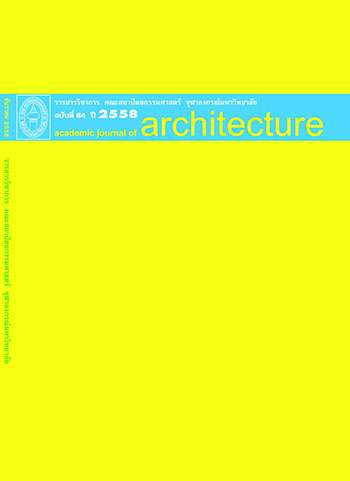The Guidelines on Landscape Improvement to Promote the Cultural HeThe Guidelines on Landscape Improvement to Promote the Cultural Heritage Value and Significance of Wat Phra Mahathat Worramahawihan, Nakhon Si Thammarat for World Heritage Nomination
Main Article Content
Abstract
Situated in Wat Phra Mahathat Worramahawihan, Nakhon Si Thammarat Province, Phra Borommathat Chedi, which is the Sri Lankan Buddhist art or bell-shaped stupa, has great historical and archaeological value on various aspects, namely the expansion of Buddhism in Southeast Asia, architectural heritage as well as beliefs and traditions in terms of customs practiced through time.
The city of Nakhon Si Thammarat including many public and private sectors altogether proposed Wat Phra Mahathat Worramahawihan, Nakhan Si Thammarat as a UNESCO’s World Heritage site. School of Architecture and Design, Walailak University was assigned to study and design the renovation to the core zone of Wat Phra Mahathat Worramahawihan based on the World Heritage’s selection criteria, law and regulations, heritage conservation method, history, beliefs, traditions and customs. Then, the findings on land use, thoroughfares, open space, visual perception, and cultural tourism management were utilized as the guidelines on landscape improvement and suggestions on imposing appropriate measures so as to underscore the importance of Wat Phra Mahathat Worramahawihan as a marked historic site and to meet the criteria of the UNESCO’s assessment on Outstanding Universal Value (OUV) of cultural heritage sites.
Article Details
References
กระทรวงทรัพยากรธรรมชาติและสิ่งแวดล้อม. สำนักงานนโยบายและแผนทรัพยากรธรรมชาติและสิ่งแวดล้อม. การเตรียมการขึ้นทะเบียนแหล่งมรดกโลก. กรุงเทพฯ : บริษัท โมโนกราฟ สตูดิโอ จำกัด, 2556.
เกษตรศาสตร์, มหาวิทยาลัย. “ประเพณีแห่ผ้าขึ้นธาตุ.” สืบค้น 18 กันยายน 2557. http://pirun.ku.ac.th/~b5411050651/page3.html.
ปิ่นรัชฎ์ กาญจนัษฐิติ. การอนุรักษ์มรดกสถาปัตยกรรมและชุมชน. พิมพ์ครั้งที่ 1. กรุงเทพฯ : จุฬาลงกรณ์มหาวิทยาลัย, 2552.
ประทุม ชุ่มเพ็งพันธ์. ประวัติศาสตร์อารยธรรมภาคใต้. กรุงเทพฯ : สวีริยสาสน์, 2544.
เมืองคอนดอทคอม. “แผนที่เมืองเก่านครศรีธรรมราช.” สืบค้น 30 พฤศจิกายน 2556. http://www.gotonakhon.com/?p=12368.
วิเชียร ณ นคร และคณะ. นครศรีธรรมราช. กรุงเทพฯ : อักษรสัมพันธ์, 2521.
ศิลปากร, มหาวิทยาลัย. รายงานฉบับสมบูรณ์ โครงการจัดทำแผนการอนุรักษ์และปรับปรุงสภาพแวดล้อมเมืองเก่านครศรีธรรมราช. กรุงเทพฯ : คณะสถาปัตยกรรม-ศาสตร์ มหาวิทยาลัยศิลปากร, 2539.
สำนักงานโบราณคดี และพิพิธภัณฑ์สถานแห่งชาติที่11 นครศรีธรรมราช. ประวัติศาสตร์โบราณคดีนครศรี-ธรรมราช. กรุงเทพฯ : บริษัทเอ.พี. กราฟิก ดีไซน์ และการพิมพ์ จำกัด, 2543.
สำนักงานปลัดกระทรวงวัฒนธรรม. การเตรียมการนำเสนอแหล่งมรดกเพื่อขึ้นบัญชีมรดกโลก. กรุงเทพฯ : บริษัท สหมิตรพริ้นติ้งแอนด์พับลิสชิ่ง จำกัด, 2555.
สำนักงานโยธาธิการและผังเมืองจังหวัดนครศรีธรรมราช. ผังเมืองรวมนครศรีธรรมราช (ปรับปรุงครั้งที่ 2). นครศรีธรรมราช : (ม.ป.ท.), 2551.
สนอดกราส, เอเดรียน. สัญลักษณ์แห่งพระสถูป. พิมพ์ครั้งที่ 2. กรุงเทพฯ : อัมรินทร์ปริ้นติ้งแอนด์พับลิซซิ่ง, 2542.
Cullen, G. Vision of Urban Design. London: Academy Edition, 1996.
Hedman, R., and Jaszewki, A. Fundementals of Urban Design. New York: McGraw-Hill, 1979.
Kostof, S. The City Assembled. London: Thames and Hudson, 1992.
Lynch, K. The Image of the City. Cambridge, MA.: The MIT Press, 1960.
Moughin, C. Urban Design: Street and Square. Oxford: Butterworth-Heinemann, 1992.
UNESCO. “Operational Guidance for the Implementation of the World Heritage Convention.” Accessed August 25, 2012.http://whc.unsco.org/en/guidelines/.


